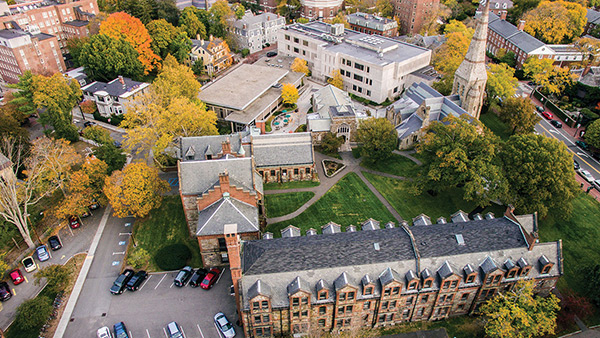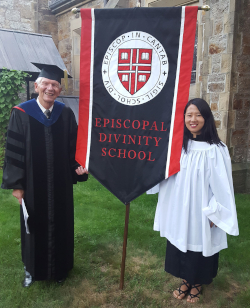 |
|
William C. Nelsen oversaw the sale of the Episcopal Divinity School campus (above) to Lesley University, a nearby institution in Cambridge, Massachusetts.
Credit: Mark Teiwes/Lesley University
|
The assignment was daunting and the timeline was tight. As the newly named interim president of Episcopal Divinity School (EDS), I had two years to work through a series of tasks that would culminate in the sale of EDS’s Cambridge, Massachusetts, campus. The governing board had voted to end the school’s 150-year presence in the Boston area and pursue a partnership with a yet-to-be-determined seminary. Trustees had given me a written set of expectations. Topping the list: Come in and calm things down.
As a member of The Registry, a national agency supporting interim placements in colleges, universities, and seminaries, I had served as an interim before, but I had never been asked to close a campus and move a seminary’s operations to a new location. The situation was unique, and I wondered if the mission was possible.
The EDS community — faculty, staff, and alumni — was understandably angry about the decision to shutter the historic property. My arrival on September 1, 2016, did little to ease the tension. I was an outsider recruited to help identify a partner school, oversee severance packages, arrange teach-out provisions for students, place the campus on the market, and determine what to do with a century-and-a-half’s worth of artifacts and archives. I was neither part of the school’s academic community nor a member of its denomination. Instead, I was possibly the first Lutheran ever to serve as president of an Episcopal seminary.
In retrospect, the journey from hurt to healing was slow and challenging, but ultimately rewarding. By the time my two-year assignment wrapped up, various parts of the EDS family had progressed from anger to understanding, from a sense of loss to a sense of anticipation, and from a lack of trust to an openness to listen. Two activities served as significant bookends to this process. At the outset, every administrator and faculty member had the opportunity to meet with me one on one for the purpose of sharing concerns and venting feelings. My role was to listen and learn. Then, at the end of the process, the diverse EDS community was invited to gather for the deconsecration of the chapel. This worship event brought together former negative voices and more moderate voices to proclaim a time of healing and a willingness to move on to a new future in a new place.
Between these bookends was the process itself. On reflection, I believe that everyone who participated — including me — gained valuable insights and learned important lessons. To other seminary leaders who may face similar circumstances in the future, I offer the following thoughts.
1. One advantage of being small
In general, the administrative and academic functions of seminaries are similar to those of colleges and universities. Relationship issues among board, staff, faculty, students, graduates, donors, and friends are much the same. The need for strategic visioning, active marketing, assertive advancement activities, academic quality, and sound financial management are present. On the other hand, seminaries are smaller, have a more limited academic scope, and depend heavily on denominational and congregational partners to help recruit students. This allows for a greater sense of community-building and mutual support if the institution is well led and administered.
2. The value of “outside” leadership
Hiring an interim president with an independent, “non-partisan” posture had many hidden benefits. It allowed for careful listening, understanding, and openness in personal conversations. These led to the process of rebuilding community. This independent perspective was beneficial as I worked with board leadership to craft a strong partnership for the future. That said, it was helpful that our denominational backgrounds, although different, were compatible. The “full communion” agreement between my denomination (Evangelical Lutheran Church in America) and the seminary’s (Episcopal Church) enabled me to conduct worship services, including the Eucharist.
3. The importance of finding the right partner
The EDS board undertook a thoughtful and systematic process to find the best partner to build an innovative and successful seminary model. The trustees were wise to design and implement the plan while they still had a sizable, although declining, endowment. I was pleased to be part of the visiting team that considered three short-list candidates for what the board envisioned as an affiliation, not a merger. In the end, our site visits confirmed that Union Theological Seminary in New York was the logical choice as our partner institution. We based our decision not only on Union’s excellent academic reputation and its solid financial position, but also on its devotion to social justice. This was in concert with EDS’s long-held mission to seek justice, love, and reconciliation in God’s world. Transition activities of the past year have been smooth, affirming our belief that Union was the right partner for EDS.
 |
| William C. Nelsen (left) and a seminarian at the opening ceremonies for the final academic year at Episcopal Divinity School on the Cambridge Campus. |
4. The wisdom of seeking expert advice
Closing a campus, marketing and selling property, handling hundreds of details, and encountering a few unwelcome “surprises” require in-house patience and outside knowledge. We learned that assembling a team of excellent advisors is critical. Our go-to panel included experts in real estate marketing and financial pricing as well as persons who knew the value and proper handling of arts and artifacts. A seasoned archivist helped us to prepare items for transfer, as authorized by the board, either to Union or to the Episcopal archives in Texas. Rather than simply disposing of books that duplicated the holdings of the Union library, we searched for a home where they would be valued and used. We were delighted to donate most of our library materials to three Anglican seminaries in central Africa.
5. The ongoing need for worship
We conducted worship services regularly throughout the entire transition process. We held daily Morning Prayers, plus two other services each week to gather the community for mutual caring and support. When courses ceased on the Cambridge campus, we held a service of “blessing and sending” for all students, faculty, and staff. As a prime example of the power of prayer, our deconsecration service in our chapel provided a powerful way to unite and say goodbye to the campus. Representatives from various parts of the EDS community helped lead the service that included a final Eucharist. An alumna gave the homily and articulated the feelings of many in attendance, saying, in essence, “Yes, it’s sad, but we are now called to move on.” It’s not the building that is most critical, she said, but the ongoing mission of the seminary and the mission of the church. We left the gathering with a sense of closure and of confidence that EDS will continue to make a positive and lasting difference as it lives out its mission in its new setting.